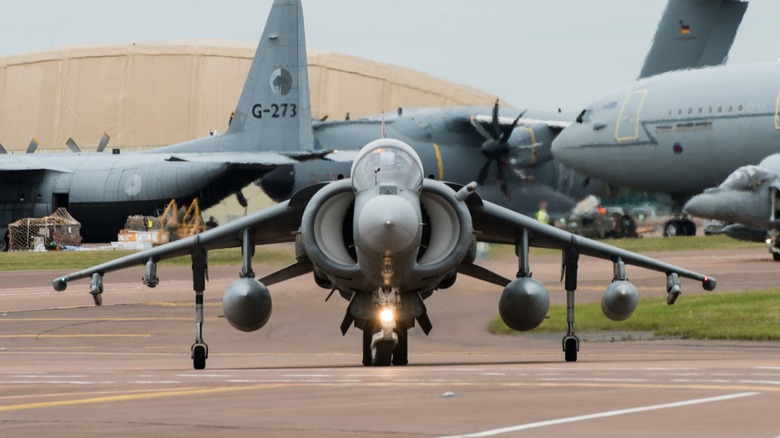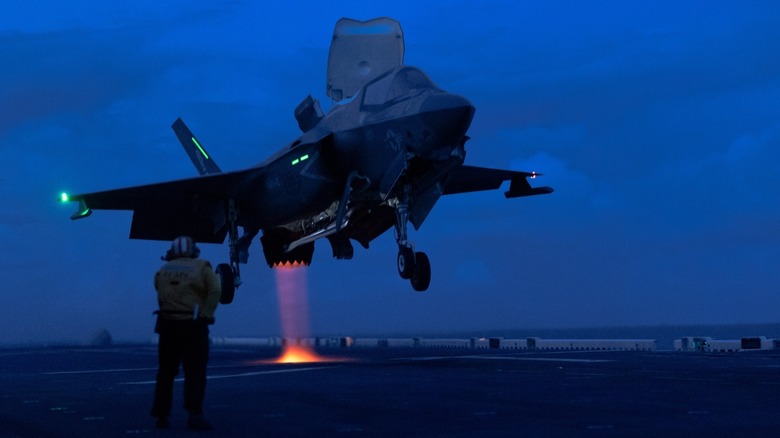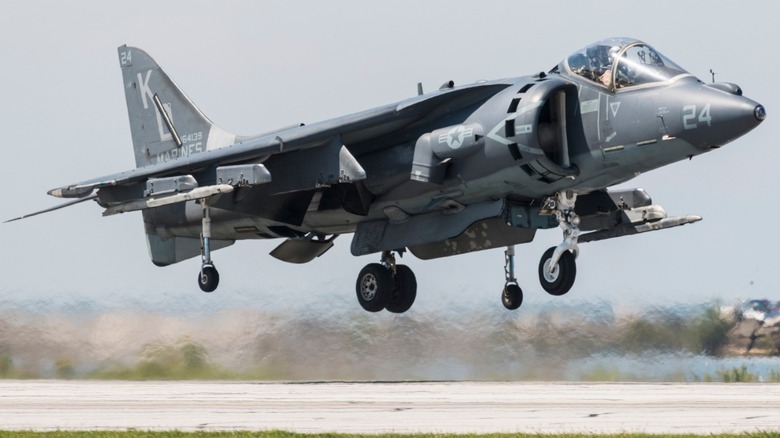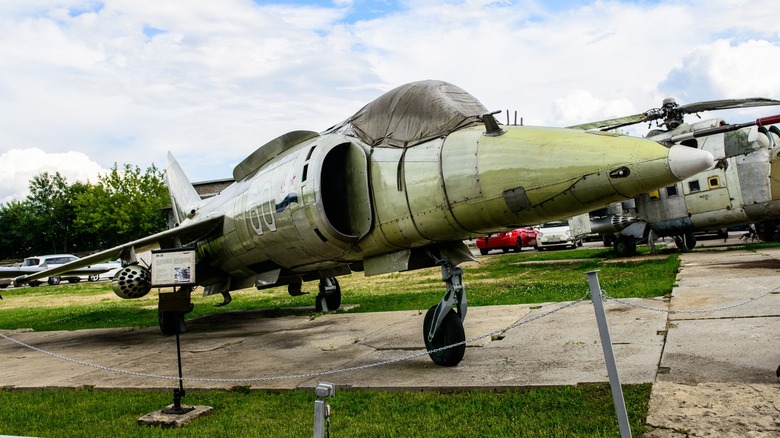4 Fighter Jets That Can Take Off And Land Without A Runway
Not every plane has the luxury of very long airport-worthy runway strips. In fact, many combat scenarios are in non-ideal locations that often do not come with a nice long runway for landing and takeoff. The ability to take off and land with limited or no runway space has been a very important factor in military aircraft since the Cold War era. After World War II, it became quite clear that having jets that didn't need runways allowed you to deploy them from a position closer to action, and you also don't need to store them in a base. That meant you could still have available fighter jets if all your air bases are destroyed.
A combat helicopter might be able to take off and land without a strip, but it doesn't typically come with the range, stealth, speed, and capacity of modern fighter jets. Engineers solved this problem by creating VTOL (vertical take off and landing) jets. They work by pushing all the thrust downward instead of behind the plane, making it hover, ascend vertically, then when it reaches a sufficient height, thrust is sent backwards to propel the jet forward.
The first operational VTOL fighter jet was the Hawker Siddeley Harrier "jump jet," made in the U.K. and deployed by both the British and the U.S. military. It proved that a jet could take off from virtually anywhere — a carrier deck, a clearing, or makeshift forward base — and still deliver the speed and firepower of a conventional fighter. It paved the way for many of the VTOL jets we've come to rely on. Here's a list of some of the more popular ones.
F-35B Lightning II
The Lockheed Martin F-35B Lightning II ranks as the best VTOL fighter jet out there right now. It's a variant of the widely-used F-35, which some consider to be the most advanced jet in the world. As a standard, F-35s are packed with some really formidable features; for instance they come stealth technology to reduce radar signature, they also have a powerful sensor fusion system that gives pilots a real-time, 360-degree view of the battlefield, supersonic 1,000+ mph speeds, and a secure, state-of-the-art data-sharing network.
What earmarks the F-35B from its standard (F-35A) and naval siblings (F-35C) is that it was built specifically with short takeoff and vertical landing (STOVL) capabilities, optimizing it for Marine Corps operations at beachheads where space might be a problem. To achieve its STOVL abilities, the jet uses a complex lift system developed by Rolls-Royce. This includes a vertically mounted lift fan behind the cockpit and a rear nozzle that can swivel downward, both powered by a shaft connected to the main engine. The system directs massive downward thrust, pushing nearly 20,000 pounds of cool air toward the ground, while the rear exhaust — a three-bearing swivel nozzle — rotates 95 degrees in just 2.5 seconds to provide matching thrust.
Together with roll posts under the wings, these components generate 40,000 pounds of lift. Remarkably, the transition between vertical and conventional flight is automated — all it takes is the press of a button. The system opens a series of vents and ducts mid-air, engages the lift fan via clutch, and then hands over control to the onboard flight computer, making the F-35B not only one of the most advanced STOVL fighters ever built, but also one of the easiest to fly.
AV-8B Harrier II
Before the F-35B Lightning II stole the show, the U.S. Military's only VTOL jet was the McDonnell Douglas AV-8B Harrier II. It's a member of the famous Harrier Jump Jet family, and a second-generation improvement of the first operational fighter jet, the Hawker Siddeley Harrier, we mentioned earlier. It first entered service in the 1980s as a direct result of the collaboration of McDonnell Douglas and British Aerospace. Built to replace the original Harrier AV-8A in every way, it featured composite wings, digital cockpit, and a more powerful Pegasus turbofan engine for greater payload and range.
Unlike the F-35B, with its standalone lift fan, this Harrier jump jet had four vectoring nozzles that directed engine thrust downward and allowed it to fly vertically and hover. These nozzles, two on each side of the fuselage, swivel simultaneously to redirect thrust either downward for vertical lift or rearward for forward flight. Reaction control jets located at the wingtips, nose, and tail helped to provide additional stability and make precise adjustments in mid-air. Once the jet has reached the required height, then the pilot gradually rotates the nozzles rearward, accelerating the jet forward. All of this requires significant pilot skill because precise nozzle control is crucial for stable hovering, landing, and maneuvering. This made it dangerous and extremely accident-prone, earning the nickname "Widowmaker" by 2002 after the Marine Corps had lost a third of its Harriers and 45 pilots to accidents.
There are still about 39 AV-8B Harriers in active service even after 40 years and five war deployments. However, they are being phased out and steadily replaced by the F-35B. By the end of 2027, they'll likely all be fully retired.
Yakovlev Yak-38 Forger
That's about it for all the VTOL that are still operational. From here on out, we will have to go back into the past, and this one's foundation starts in the Soviet Union. The Soviets needed a response to the Harrier jump jets, and they come up with the Yakovlev Yak-38 "Forger," their first operational VTOL jet, which entered service in 1976. Its first flight was in 1972, 13 years after the original Harrier entered service with the Royal Air Force in 1969.
However, the Yak-38 didn't enjoy the same illustrious career that its contemporary Harrier rival did. Poor reliability, bad fuel consumption and an operational radius of only about 60 miles, were only the beginning of the Yak-38's problems. It had a three-engine layout: one main engine (R27-300 turbojet with vectoring nozzles) and two vertically-mounted lift jets behind the cockpit. This gave the jet a poor thrust-to-weight ratio and efficiency, causing it to be extremely underpowered, limiting its range, speed, and payload capacity, making it one of the worst fighter jets of all time.
It had under 200 miles of range — less than half of that of a Harrier — and a reputed external load capacity of only about 1,325 pounds. The inefficiency and unreliability forced pilots to use the jet as an STOL on short runways to save fuel and carry more load — when they agreed to fly it at all. The Yak-38 was retired in the early 1990s, and while Russia has expressed interest in developing a new VTOL fighter based on the canceled Yak-141 prototype, nothing has entered service yet.
Hawker Siddeley Harrier GR.1
Of course, this list wouldn't be complete with the original operational S/VTOL jet to enter military service; the Harrier GR. While the first version of this jet, the Harrier GR.1, never entered active service of the U.S. Military, it was what convinced the world that VTOL was not only possible but viable. In 1957, Hawker Aircraft, as a private venture, began developing the P.1127, based on the groundbreaking Pegasus turbofan engine from Bristol Siddeley. The Pegasus could vector its thrust using four swiveling nozzles, which could direct exhaust downward for vertical lift or rearward for forward flight. Hawker's engineers wrapped an airframe around it, and thus the P.1127 prototype was born.
It successfully hovered in 1960, and by the mid-1960s, a more refined version called the Kestrel FGA.1 was undergoing testing as part of a tri-nation evaluation program between the U.K., U.S., and West Germany. Encouraged by the Kestrel's success, the British government ordered a combat-capable derivative, and the Hawker Siddeley Harrier GR.1 entered the service of the Royal Air Force in 1969.
The Harrier GR.1 was a technical balancing act, powered by a Pegasus Mk 101 engine producing 19,000 pounds of thrust. That thrust made just enough for vertical takeoff under light load or short takeoff with full fuel and weapons. The pilot had to manually control the thrust vectoring with a "nozzle lever," making it a demanding aircraft to fly. Though subsonic and equipped with basic avionics (it had no radar and only a simple navigation system), it could carry up to 5,000 pounds of ordinance, including bombs, rockets, and twin 30-millimeter ADEN cannons, making it the perfect aircraft for low-altitude strike missions against enemy armor and supply lines.




